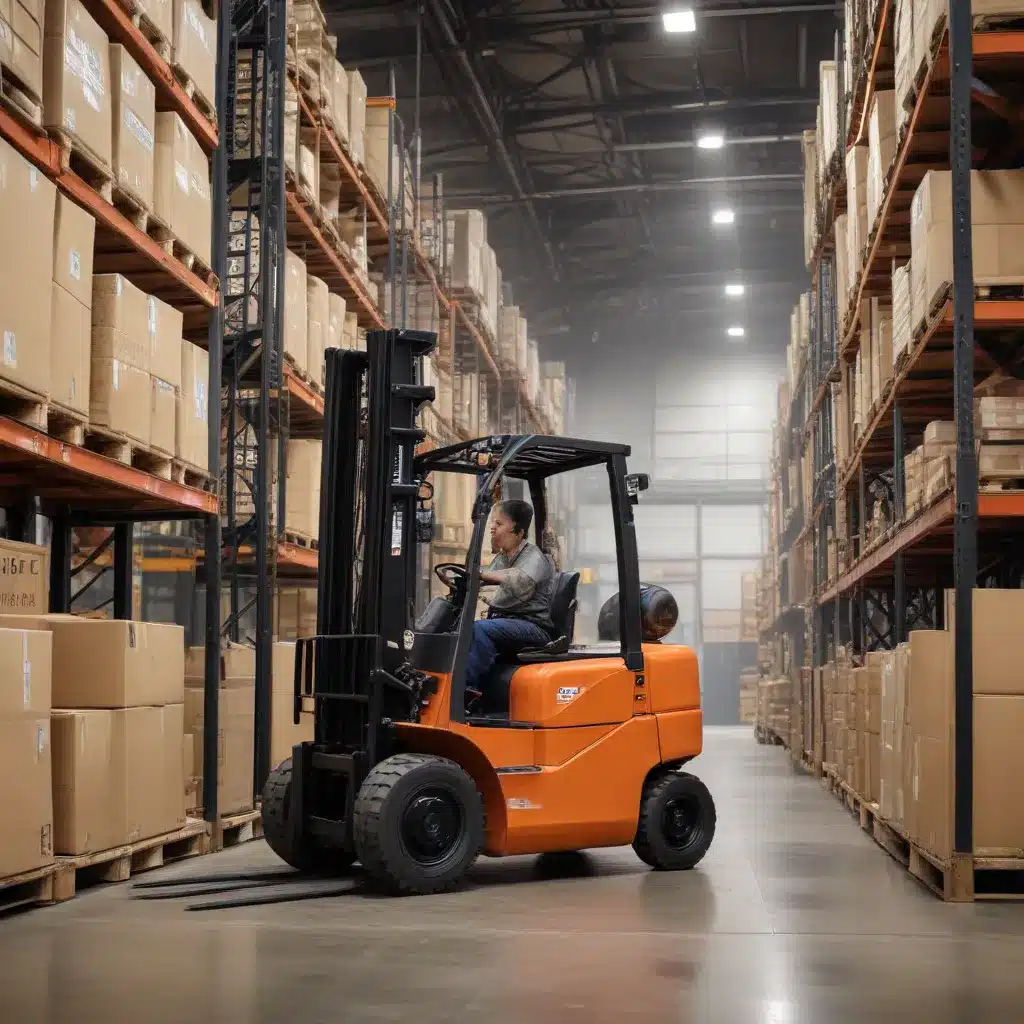
The Evolving Landscape of Forklift Safety
As the material handling industry continues to prioritize workplace safety, the integration of advanced sensor technologies has emerged as a pivotal strategy for enhancing forklift operator assistance and load handling capabilities. Forklift automation has gained significant traction in recent years, with a focus on innovative safety features, improved workflow efficiencies, and other business-critical advantages.
The evolution of forklift technology has transformed the way operators interact with these essential tools, providing comprehensive safety measures and optimizing various aspects of their performance. From sensor-based detection systems to advanced stability control mechanisms, forklift manufacturers have developed an array of cutting-edge solutions to mitigate risks and empower operators to handle loads with greater precision and confidence.
Sensor-Driven Operator Assistance Systems
At the forefront of this technological revolution are forklift operator assistance systems, which seamlessly integrate a variety of sensors, alarms, and cameras to enhance the operator’s awareness and control during critical maneuvers. These systems can detect obstacles, monitor speed, and automatically adjust forklift behavior to prevent accidents and optimize productivity.
One such innovative system leverages detection sensors and cameras to alert the operator when their path is obstructed, while speed sensors automatically slow the forklift when approaching busy intersections or other high-traffic areas. This integrated technology empowers operators to navigate with heightened situational awareness, reducing the risk of collisions and ensuring a safer work environment for both the operator and surrounding personnel.
Moreover, the integration of stability control systems helps maintain the forklift’s balance, even when carrying heavy or uneven loads. These systems continuously monitor the forklift’s center of gravity and adjust its movements accordingly, preventing dangerous tip-overs and enhancing the overall stability and handling capabilities.
Enhancing Visibility and Environmental Awareness
Improved lighting technology also plays a crucial role in enhancing forklift operator assistance. Strategically placed light sensors and brighter illumination help illuminate dark warehouse aisles and other low-visibility areas, providing operators with better visibility and improved navigational capabilities, especially during night shifts or in dimly lit environments.
Beyond visual enhancements, forklift operator assistance systems can also leverage telematics and GPS technology to monitor the forklift’s performance and location in real-time. This data can be used to track efficiency, diagnose maintenance requirements, and identify potential safety concerns, enabling fleet managers to make informed decisions and proactively address issues before they escalate.
Addressing the Challenges of Forklift Automation
While the benefits of forklift automation are numerous, it’s essential to consider the potential challenges and considerations that come with these innovative technologies. Automation can promote forklift independence and self-sustainability, but it also requires a comprehensive understanding of the system’s capabilities and limitations to ensure seamless integration and maximum effectiveness.
One of the key considerations is the need for comprehensive operator training on the specific features and functionalities of the forklift’s sensor-driven assistance systems. Ensuring that operators are well-versed in the system’s alerts, user interface, and proper response protocols is crucial for maintaining a high level of safety and efficiency.
Additionally, the integration of these advanced technologies may require adjustments to existing workflows, infrastructure, and safety protocols to fully capitalize on their benefits. Warehouse managers must be proactive in evaluating their operations and implementing complementary measures, such as dedicated pedestrian walkways, physical barriers, and comprehensive safety signage, to create a holistic safe environment.
Toward a Safer and More Efficient Future
As forklift automation continues to evolve, the future holds even more promising developments that will further enhance operator assistance and load handling capabilities. Advancements in sensor technology, artificial intelligence, and predictive analytics are poised to provide forklift operators with increasingly intelligent and proactive support systems.
For example, the integration of real-time object detection and collision avoidance algorithms can enable forklifts to anticipate and react to potential hazards with lightning-fast precision, minimizing the risk of accidents and ensuring the safety of both operators and pedestrians. Additionally, the integration of machine learning-driven diagnostics can help predict maintenance requirements and optimize fleet performance, reducing downtime and improving overall operational efficiency.
By embracing the power of sensor integration and operator assistance technologies, Forklift Reviews is committed to empowering material handling professionals with the tools and insights needed to navigate the evolving landscape of forklift safety and productivity. Through in-depth reviews, practical guidance, and industry-leading expertise, we strive to help our readers make informed decisions and implement effective solutions that elevate their operations to new heights of safety and success.
Unlocking the Full Potential of Forklift Automation
The integration of sensor-driven operator assistance systems represents a transformative shift in the material handling industry, ushering in a new era of enhanced forklift safety, efficiency, and productivity. By leveraging advanced technologies that augment the operator’s capabilities, businesses can unlock a wealth of benefits, from improved load handling and reduced accident risks to enhanced fleet management and optimized workflow processes.
As the industry continues to embrace these innovative solutions, it is crucial for forklift operators, fleet managers, and warehouse supervisors to stay informed and proactive in their approach to forklift safety and automation. By partnering with trusted industry experts and embracing the power of sensor integration, organizations can position themselves for long-term success, while ensuring the well-being of their most valuable assets – their employees.
To learn more about the latest forklift technologies and how you can implement operator assistance systems to enhance your material handling operations, visit Forklift Reviews for comprehensive industry insights and expert guidance.

